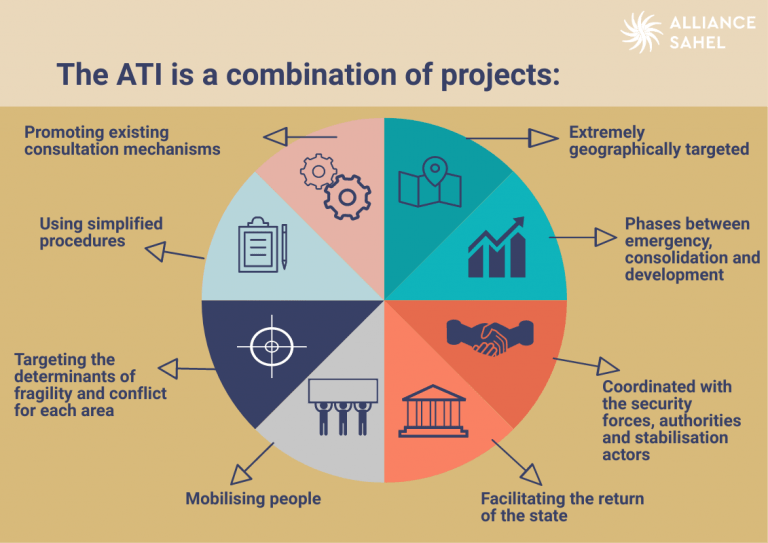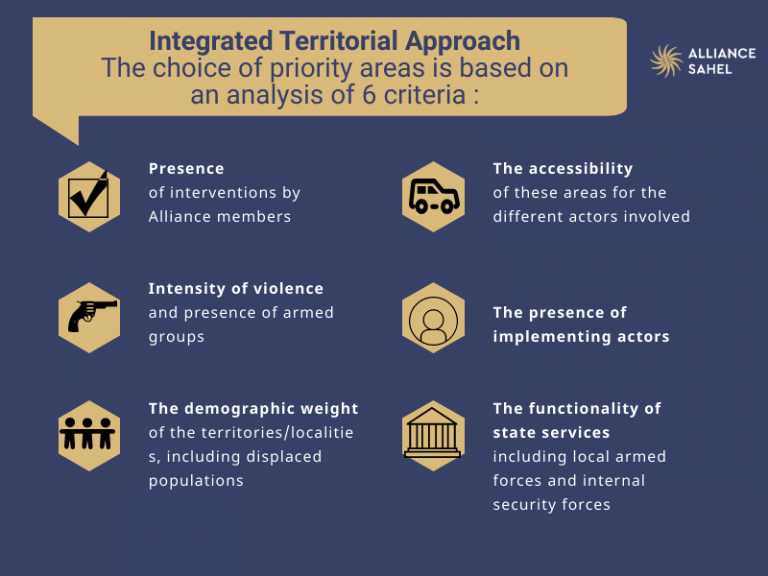The Integrated Territorial Approach (ATI): An approach to aid adapted to fragile areas
In the face of the worsening of conflicts in many regions of the Sahel and their multiple consequences on the living conditions of the populations, the international community is seeking to strengthen the relevance, effectiveness and impact of its aid in these areas, paying particular attention to the prevention and treatment of the causes of fragility. To this end, the members of the Alliance have committed to supporting the actions of the Sahel countries in favour of the redeployment and maintenance of the state and basic services in the most vulnerable areas and have developed an innovative intervention approach: the Integrated Territorial Approach (ATI).
The Integrated Territorial Approach
At the heart of this commitment to fragile areas, the Integrated Territorial Approach (ITA) aims to respond to the most urgent needs of populations in several sectors, while addressing the root causes of crises in areas at risk.
It allows development initiatives to be better coordinated at local level, and to pool the resources and approaches of Sahel Alliance members working in these areas.
Integrated, multi-sectoral and adapted to the specificities and constraints of each territory, this approach is implemented in close coordination with the authorities of each country. It articulates the logics of security, consolidation, and prevention and pays increased attention to the most vulnerable people, women and youth, their education, training, social and economic integration, to give them confidence in the future.

Fragile areas, a key priority
Interventions in fragile areas are one of the priorities of the Sahel Alliance. These regions, which are often border regions, face major security, humanitarian and climatic vulnerabilities. Far from the capitals, they also often suffer from inadequate public services.
In 2020, ten priority areas were identified by the members, in collaboration with the authorities in each country.
These zones reflect a dual focus on conflict ares and prevention areas. The choice was based in particular on the diagnoses of the RRA (Risk and Resilience Assessment) study, led by the World Bank and the result of a collective mobilisation of the Sahel Alliance to rethink the contribution of development to peace and the prevention of violent conflicts in the Sahel.
It is important to note that while the ATI targets priority areas, this is not to the detriment of interventions in other areas/regions of the Sahel countries.
The 10 target areas have been characterised in three typologies (secure, consolidate, prevent). This implies that, depending on the situation encountered – in particular the security situation – at the territorial level, and its evolution, security, stabilisation and development actions can be tackled successively or form a “nexus”. In the latter case, the phases are combined and the actors intervene simultaneously, taking care to ensure the coherence and if necessary the adaptation of the actions implemented.

Implementation of ATI
The ATI helped support the implementation of the regional growth strategy for the Hodh Ech Charqui priority area in Mauritania and strengthen dialogue with local authorities in the Kanem and Barh-el-Ghazel priority areas in Chad.
Pragmatic tools for a concrete implementation
In order to facilitate the implementation of the ATI, decision support tools for development interventions in the selected areas have been created:
- The “integrated territorial approach” database lists the activities of Sahel Alliance members in these areas and contextual data. This database allows for mapping and cross-analysis to optimise coordination between members within the ATI framework and to facilitate decision-making and operational planning of activities.
- The AFD-funded Plateforme d’Analyse, de Suivi et d’Apprentissage au Sahel (PASAS) makes available the knowledge and studies available on the Sahel region to help design projects.
In addition to strong coordination with the authorities, who are fully involved in the definition and implementation of ATI, the involvement of beneficiaries, populations, local communities and territorial administrations is essential for the success of this approach.
The operational strategies defined in each area will be based on local development plans, with appropriate operating methods and measurable success indicators.
Go further

